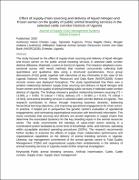| dc.contributor.advisor | | |
| dc.contributor.author | Lagu, Charles | |
| dc.contributor.author | Kugonza, Sylvester | |
| dc.contributor.author | Oluka Nagitta, Pross | |
| dc.contributor.author | Andama, Morgan | |
| dc.date.accessioned | 2021-05-07T08:44:30Z | |
| dc.date.available | 2021-05-07T08:44:30Z | |
| dc.date.issued | 2020-08-18 | |
| dc.identifier.citation | Lagu, C., Kugonza, S., Nagitta, O. P. & Andama, M. (2020). Effect of supply-chain sourcing and delivery of liquid nitrogen and frozen semen on the quality of public animal breeding services in the selected cattle corridor districts of Uganda. Journal of Supply Chain Management Systems 9 (4) 2020, 21-32. | en_US |
| dc.identifier.issn | 2277-1387 | |
| dc.identifier.uri | http://www.publishingindia.com/jscms/41/effect-of-supply-chain-sourcing-and-delivery-of-liquid-nitrogen-and-frozen-semen-on-the-quality-of-public-animal-breeding-services-in-the-selected-cattle-corridor-districts-of-uganda/10918/16301/ | |
| dc.description.abstract | The study focused on the effect of supply-chain sourcing and delivery of liquid nitrogen and frozen semen on the public animal breeding services in selected cattle corridor districts (Mbarara, Mubende, Luwero & Soroti) of Uganda. The research adopted a cross-sectional survey with mixed methods that involved concurrently collecting both quantitative and qualitative data using a structured questionnaire, focus group discussions (FGD) guide, together with interviews of key informants in the case of the Uganda National Animal Genetic Resources and Data Bank (NAGRC&DB). Extant records review was deployed throughout. The study hypothesised that there was a positive relationship between supply-chain sourcing and delivery of liquid nitrogen and frozen semen and the quality of animal breeding public services in selected cattle corridor districts of Uganda. The findings showed a positive relationship between sourcing (?2 = 13.895, p = 0.003, ?2 critical = 7.815), delivery (?2 = 20.900, p = 0.013, ?2 critical = 16.919), and animal breeding services in selected cattle corridor districts of Uganda. This research contributes to theory through improving business dexterity, bolstering hierarchical learning objectives, and improving operational engagements for chain actors. In practice, it helped put in perspective the genetic centre’s evaluation of operational engagements, and contrasting organisational execution with benchmark information. The study concludes that sourcing and delivery are pivotal segments in supply chains that determine the associated dynamics for the key breeding inputs in the animal resources sector. The study recommends the interplay of value-chain actors working in a coordinated system facilitated by some level of knowledge, skills, and interests, operating within acceptable standard operating procedures (SOPs). The research recommends further studies to examine the effects of supply chain collaboration performance and organisational capabilities on the delivery of animal breeding services in Uganda. Likewise, top management commitment of the animal genetic centre to Total Quality Management (TQM) and organisational supply-chain ambidexterity in the delivery of animal breeding services in Uganda needs further empirical investigation. | en_US |
| dc.language.iso | en | en_US |
| dc.publisher | Journal of Supply Chain Management Systems | en_US |
| dc.relation.ispartofseries | Vol.9;No.4 | |
| dc.subject | Artificial insemination | en_US |
| dc.subject | Cattle | en_US |
| dc.subject | Cattle corridor | en_US |
| dc.subject | Public animal breeding services | en_US |
| dc.subject | Supply chain | en_US |
| dc.subject | Supply chain management | en_US |
| dc.title | Effect of supply-chain sourcing and delivery of liquid nitrogen and frozen semen on the quality of public animal breeding services in the selected cattle corridor Districts of Uganda | en_US |
| dc.type | Article | en_US |

